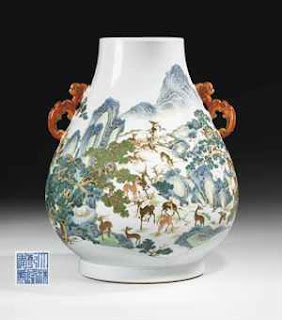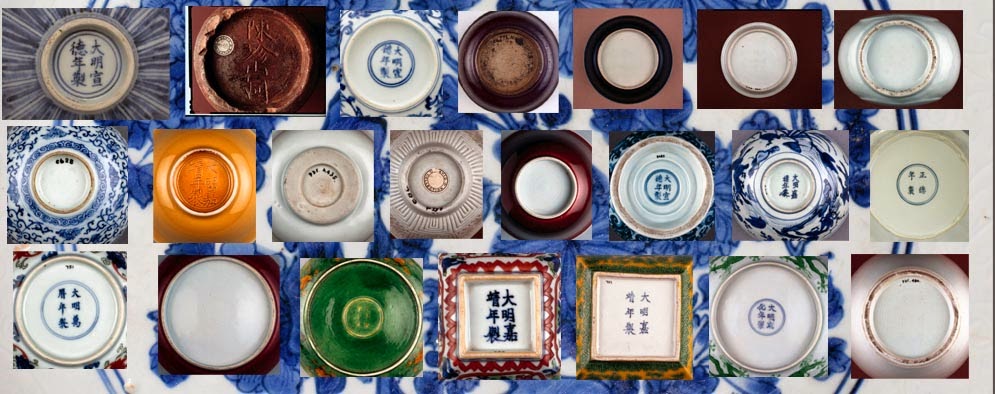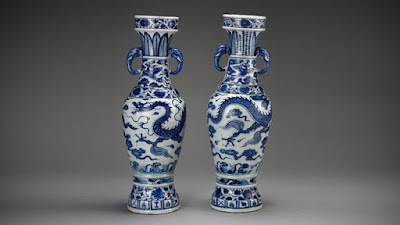The Chinese Art Market Bubble
Yes The Bubble of all Market Bubbles, Chinese Art and Antiques
Its no secret that over the last 20 years the amount of private wealth in China has risen dramatically.Whenever you have a rapid expansion wealth, in particular extreme wealth, money starts to get spent on everything from luxury cars, jewelry, larger and better houses, vacations, yachts, jewelry and of course art. All very normal. |
| Rare late 18th C Qianlong Vase, Sold at Christies for 2.2 million British Pounds |
Happily Communism failed as it has everywhere around the world and Communist China was forced to embrace capitalism to support the dying communist cause. Slowly China's strict controls on foreign trade have relaxed, bringing a better life for hundreds of millions of Chinese citizens and money, lots of it.
As these controls have been relaxed, the entry into the world art market by Chinese nationals has created enormous pressure on prices, Chinese Imperial porcelains to carved jades and 20th C. Scroll paintings have all spiked in value. You name it, if its a Chinese antique or painting created for the domestic market, its worth more in most cases by multiples over a couple decades ago.
China's rapid economic expansion has created a bubble..a huge bubble in the art market.
 |
| Rare Qianlong vase, Sold by Bohnams London, $14,000,000, yes MILLION! |
Sorry, the Chinese Art market bubble is very real and the latest auction sale's results prove it with the number of unsold lots for middle range items increasing. The first stage in a bubble getting ready to burst is a leveling off of values, starting first with the less than top range material. High auction gross sales mixed with widening Buy In ratios indicates weakness.
This burst could be accelerated if the Chinese Government is unable to sustain it's economic growth at the rate it has been for the past decade and a half. Weakened financial markets in the EU , South America and more competition from India may exacerbate and work against China's growth.
In the art market you've always had two basic groups; The true trophies and everything else. The TRUE TROPHIES are the best of the best by category. These items drive the entire market right down to the prices realized on a Saturday after noon estate auction in central Maine. When the top of the market feels a category flattening out or weaken, not unlike Dominoes the entire sector does as well. It may also spread to related groups almost like an infection. The Japanese art market collapsed 20 years ago and has never come back as did the buying by the Japanese for Impressionist paintings.
 |
| Qi Baishi Painting $65, 000,000 sold By Guardian Auctions , Hong Kong |
Will all of the Chinese prices drop hard? No, the top will likely level off with the possible exception of paintings and the very very finest pieces still reaching new highs, but everything less than spectacular will be bought with more selectivity. This "selectivity" will bring more sales results like those conducted by Christie's and Sothebys this past Spring in New York, London and Hong Kong. The very top pieces fresh to the market did great, the rest? Not so much with "buy-ins" due to excessive estimates and lesser demand coupled for weak results in those category's.
In the not too distant future, within 2 years, the weakening interest in the upper middle market down to the bottom end i.e. things selling for under $10,000 will become weaker still. More and more folks who bought during the boom will switch from collector driven to protecting capital investment driven as they see lower prices in the auction market and fewer items making reserves.. This will cause a growing flood of goods into the market, starting with Jades, Rhino Horns (stupidly overpriced) and of course porcelains.
Diversification
The flip downside of bubbles can also be seen when those driving a market begin to diversify their buying. This is happening today in China. In the last few years, Jackson Pollocks', fine French furniture, Dutch paintings and rare watches as well as fine jewelry have become in vogue. Tastes in China are broadening, this will further weaken demand for Chinese works of art, with the exception of the great rarity.Fakes and the Chinese Antiques Market
Adding fuel to the fire many collectors will learn that what they bought are fakes over the last 20 years.These fakes have been pumped out of China by forgers like oil out of the Bahken and have flooded the lower end auction houses across America for years. From Skinners in Boston to DuMuochelles in Detroit and Sloans and Kenyon in Maryland they have all moved millions of dollars in modern reproductions to unwitting amateur buyers all of whom were hoping to score on an overlooked rarity. Does this mean these small auction houses never sell authentic items? No, it doesn't, however they simply have very poor history's with regards to authentication and providing accurate pre-sale descriptions, leaving the buyer with having to make the decision of authentication with no help from the auctioneer, while in many cases claiming defacto "expertise" on their websites.
Smaller Auction Houses and Fakes
For the most part these auction houses, knew or should have known so many of these items are reproductions, did refrain in most cases from dating or giving any indication of authenticity for the lots being sold. In other words, "you are the experts, not us". For proof of this duplicity you only need look at their auction estimates. These estimates say they either have no idea what they are doing, or are witting partners in this fraud, or are just trying to make a buck while covering their behinds. Either way, the buyer's lose.These realizations by owners of fakes will cause more objects to enter the market as their owners desperately try to get rid of them and recoup the money spent. In reaction the major auction houses i.e. Christies (my personal favorite), Sothebys, Bonhams and Gaurdian in Hong Kong will impose provenance requirements for consignors to meet. (Who you bought objects from does not create provenance.) Causing a second flood onto the market via the same auction houses who sold many of the fakes originally and may now be less wiling to re-sell. Or if they are willing to re-sell them they will require most likely those same old low estimates, leaving the seller with a Hobson's choice.
 |
| plcombs, Dealers and Appraisers of Asian Antiques and Art |
It will be a mess. Jades have already started to weaken as they are by far the largest group of reproductions on the market numbering in the Millions. Many of which have been sold for tens of thousands of dollars as authentic early examples. Jades can be very difficult to authenticate as to when they were carved as is the case with anything carved from stone of any kind.
Feel free to email or call with any questions about your own Chinese porcelains or their values.
Thank you for visiting ~ Peter Combs
Gloucester, MA 978-283-3524


The Chinese Art Market Bubble >>>>> Download Now
ReplyDelete>>>>> Download Full
The Chinese Art Market Bubble >>>>> Download LINK
>>>>> Download Now
The Chinese Art Market Bubble >>>>> Download Full
>>>>> Download LINK IV
Great read thankyyou
ReplyDelete